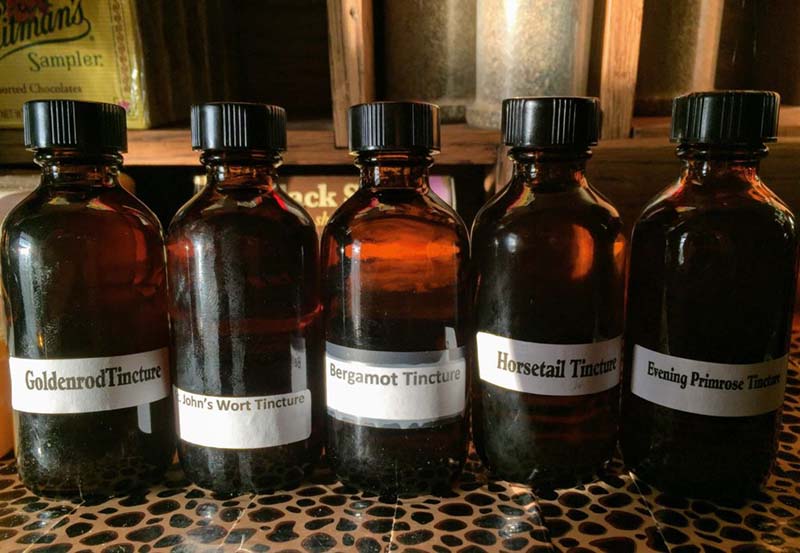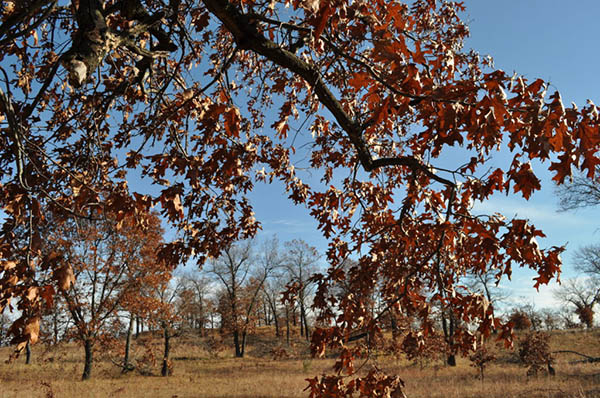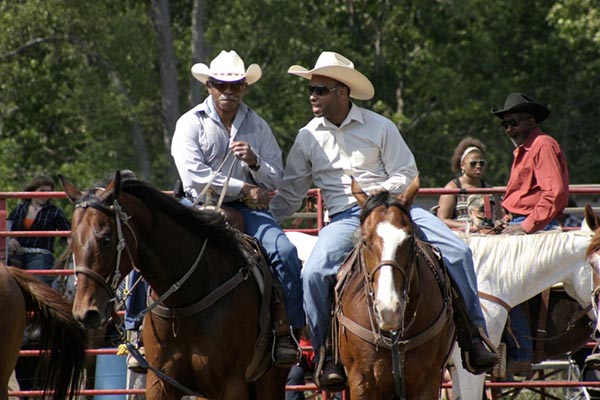A visit to Basu Farms in Pembroke Township, about 60 miles south of Chicago, provides a glimpse into the entanglement of land tenure, black history and self-determination in rural Northeastern Illinois. On one side of the main building at Basu Natural Farms, shelves line the walls containing rows of dark bottles of tincture and salves labeled ‘black walnut,’ ‘St. John’s wort,’ ‘horsetail,’ and many others. Pam Basu makes these herbal medicines primarily from plants that she grows organically or wild harvests. The Basus also sell vegetables and flowers produced on the farm. On the other side of the building is a small museum displaying objects that highlight the African-American experience in this region. For many Pembroke residents, land tenure and the form their livelihoods take cannot be disconnected from local black knowledge traditions and the struggle for post-Jim Crow enfranchisement. The annual Marcus Garvey festival held on the Basu Farm, and a summer rodeo, are demonstrations of black pride expressed through identities and expertise related to the land.

Pam Basu instructs customers on uses for her tinctures and salves. Photo by the author.
In this post, I briefly consider how historic cultural and ethnic ties to contested landscapes can influence biodiversity conservation initiatives in the United States. Land conservation for biodiversity protection is regularly fraught with conflict. Conservation initiatives often are perceived by local landowners and leaders as threats to sovereignty and an infringement on land use decision-making. Differences rooted in race, class and beliefs about what constitutes “nature” can widen gaps between conservation organizations and the people residing near lands targeted for protection. Yet conservation projects can provide resources for communities and advance local interests when trust is established and common ground identified (Wali et al. 2017). Since 2013, I have been part of a multidisciplinary Field Museum team leading a research and planning process focused on elevating and empowering community participation in conservation efforts in Pembroke Township. Here I reflect on conditions which can lead to sovereignty and social justice interests being secured in biodiversity conservation processes, drawing upon analysis of this Pembroke case.
Land Tenure Precarity and Claims of Stewardship
Joseph ‘Pap’ Tetter, his wife Mary Eliza, and their family were the first black settlers in the Pembroke area around 1861. While conflicting accounts exist about the Tetters and their origins, a prominent one holds that Pap Tetter was enslaved in North Carolina but escaped to Pembroke, where he subdivided and sold lots to help families traveling on the Underground Railroad. Records show that the Tetters took title to land in what is now called Old Hopkins Park by 1900, and other black families followed suit. Many more people arrived to Pembroke during the Great Migration, when blacks unsettled by Chicago’s violence and segregation learned from developers and word of mouth about a peaceful place south of the city that resembled southern farmland.
Since that time, land tenure has often been precarious in Pembroke Township, in part due to developers’ use of “installment contracts” which did not transfer a deed until all payments were made. Defaults over missed payments were common through much of the twentieth century. In recent decades, outmigration and heirs’ disputes primarily among black families, and an influx of Latino buyers, have also reconfigured the tenure landscape within the community. Since 2000, conservation purchasing has added complexity to this dynamic, contributing to fears of displacement among long-time residents. Basu Farms and much of Pembroke sits on a globally critically rare habitat type. Before European settlement, roughly 30 million acres of oak savanna grew in the Midwestern U.S., but only 6400 acres remained by 1985 – less than .02 percent of the original cover. The high-quality black oak savanna in Pembroke Township is even more rare, and has become a major conservation priority in the past two decades.

A savanna ridge in Pembroke Township. Image courtesy of the Field Museum (CC-BY-NC).
The entrenched poverty in Pembroke has proven complicated for conservation stakeholders eager to protect these remnants. Residents critical of conservationists are not without evidence when observing that The Nature Conservancy and similar entities benefit from regular tax sales and relatively low land prices. The precarity of land tenure presents opportunities for conservation buyers in Pembroke Township. When pressed, conservation interests have highlighted that they pay market value to willing sellers as well as property taxes, yet residents regularly claimed they had seen minimal commitment by these well-resourced groups to help address poverty, unemployment, and related social issues of local concern. Our museum team observed that while these gaps received minimal attention, the social license to operate in Pembroke for conservation groups would be tenuous at best.
One of the most common early missteps in biodiversity protection initiatives, in Pembroke and elsewhere, has been a failure to understand the heritage, social structure, and priorities of residents, and to acknowledge the deep skepticism many black and working class landowners hold for conservation writ large (Montambault et al 2017). As Dave Baron writes, “the rare, natural features of Pembroke’s black oak savannas made the land difficult to farm but allowed poor, African American migrants the chance to purchase their own property. Although they lacked capital to develop their holdings, the migrants built a distinctively rural and black community there in which connections to the land and the desire for self-determination are central to the township’s identity and future direction” (2016:11). This independence and self-reliance has emerged as a pattern in our ethnographic data, commonly framed in sentiments such as, “why do U.S. Fish & Wildlife and TNC want to take this land from us? The environment here is in good condition because we have taken care of it for generations.”
Local practices have led to the health of the black oak savannas, such as the prevalence of low impact small scale organic agriculture and ranching in the area. Another intriguing factor in the savannas’ ecological integrity is the regular introduction of fire onto the landscape through trash burning which is nearly ubiquitous due to the lack of municipal waste pick up in Hopkins Park. Residents consistently exhibit pride in their heritage of stewardship, often delivered with a hint of rebuke at presumed condescension in the suggestion that the place needs saving from (local) people.

Riders at the Pembroke Rodeo. Photo by Alexis Winter, courtesy of the 2018 Field Museum (CC-BY-NC).
Towards Community-Based Conservation
Since 2014, the Field Museum’s Keller Science Action Center Chicago Region team has played an active role in Pembroke Township. Working closely with community leaders and content experts, myself and museum colleague Erika Hasle co-curated and installed an exhibit titled Rooted: The Richness of Land and Culture in the local public library. Informed by oral history and ethnobotanical interviews, the exhibit highlighted residents’ long tradition of stewardship, herbalism, and small-scale agriculture among the black oak savannas. In 2016, the museum team facilitated a series of Quality of Life planning sessions which engaged residents and stakeholders. This process resulted in a detailed asset map, an assessment of indicators ranging from political and economic stability to social networks and cultural traditions, and a set of recommendations to guide future decision-making (Campbell, Winter, Hasle 2016). The museum was then prompted by residents, local officials, and conservation entities to more deliberately assume the position of convener, and in 2017 took a lead role in collaboratively developing a Sustainability Plan for Pembroke-Hopkins Park.
Land tenure and related conflicts have been central issues taken up in the sustainability planning process. Local land owners and conservationists have identified numerous threats that imperil practices and principles these groups share. Some of these threats include industrial hog confinements, the expansion of conventional agriculture, dune theft for sand, illegal tree cutting and poaching. As a result, an organized group of residents and local leaders has demonstrated a commitment to engage TNC and U.S. Fish & Wildlife Service, to press them to be “good neighbors,” by detailing the means through which conservation partners bring value to the community. Examples include the Youth Conservation Corps program established in Pembroke by USFW in 2017 which provides paid summer internships to local teenagers, and technical support for landowners with wetlands. This premise has accompanied greater acknowledgement among residents that in order for conservation purchasing and programs to reflect local priorities, communication and formal negotiations must be established among stakeholders. While the Sustainability Plan has been contested and remains emergent, preliminary outcomes signal that conservation decision making has grown more responsive to locally established conditions. For instance, TNC is responding formally in its acquisition strategy to locally articulated values and priorities for the Pembroke region by not targeting lands that are served by water and sewer infrastructure. Upholding just tenure rights through collaborative planning processes such as those described above provides one means of sustaining generational ties while also finding common ground in contested conservation landscapes.
References
Baron, Dave (2016) Pembroke: A Rural, Black Community on the Illinois Dunes. Carbondale: Southern Illinois UP.
Campbell, Jacob, Alexis Winter, and Erika Hasle (2016) Pembroke-Hopkins Park Quality of Life Report. The Field Museum, Chicago, Illinois.
Montambault JR, Mark Dormer, Jacob Campbell, et al. (2017) Social Equity and Urban Nature Conservation. Conservation Letters. 11(3):00:e12423.
Wali, A., D. Alvira, P. S. Tallman, A. Ravikumar, and M. O. Macedo (2017) A new approach to conservation: using community empowerment for sustainable well-being. Ecology and Society 22(4):6.
